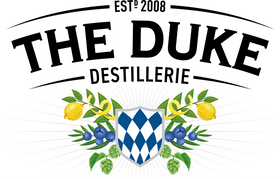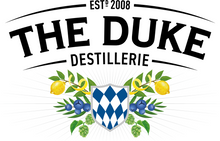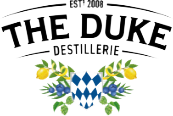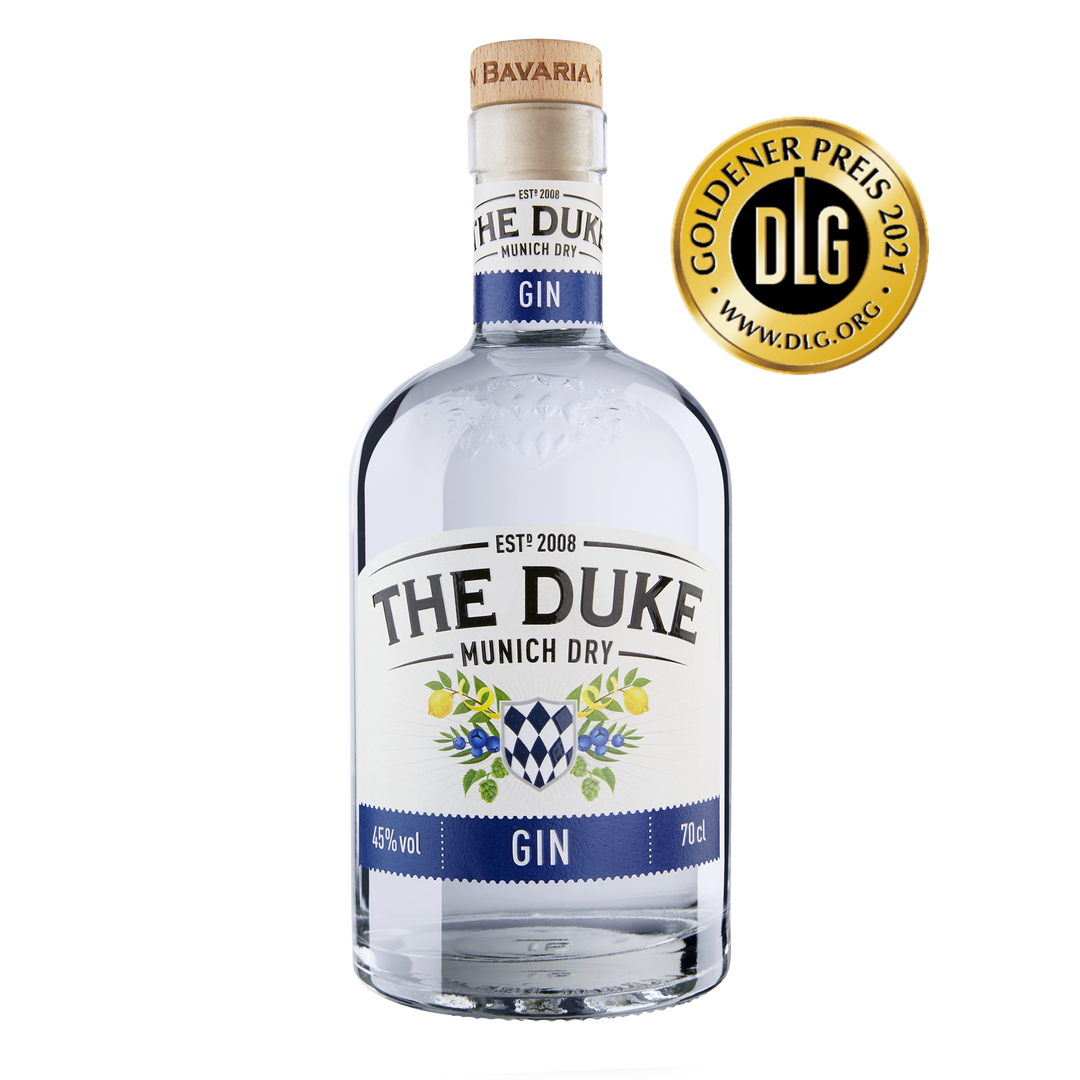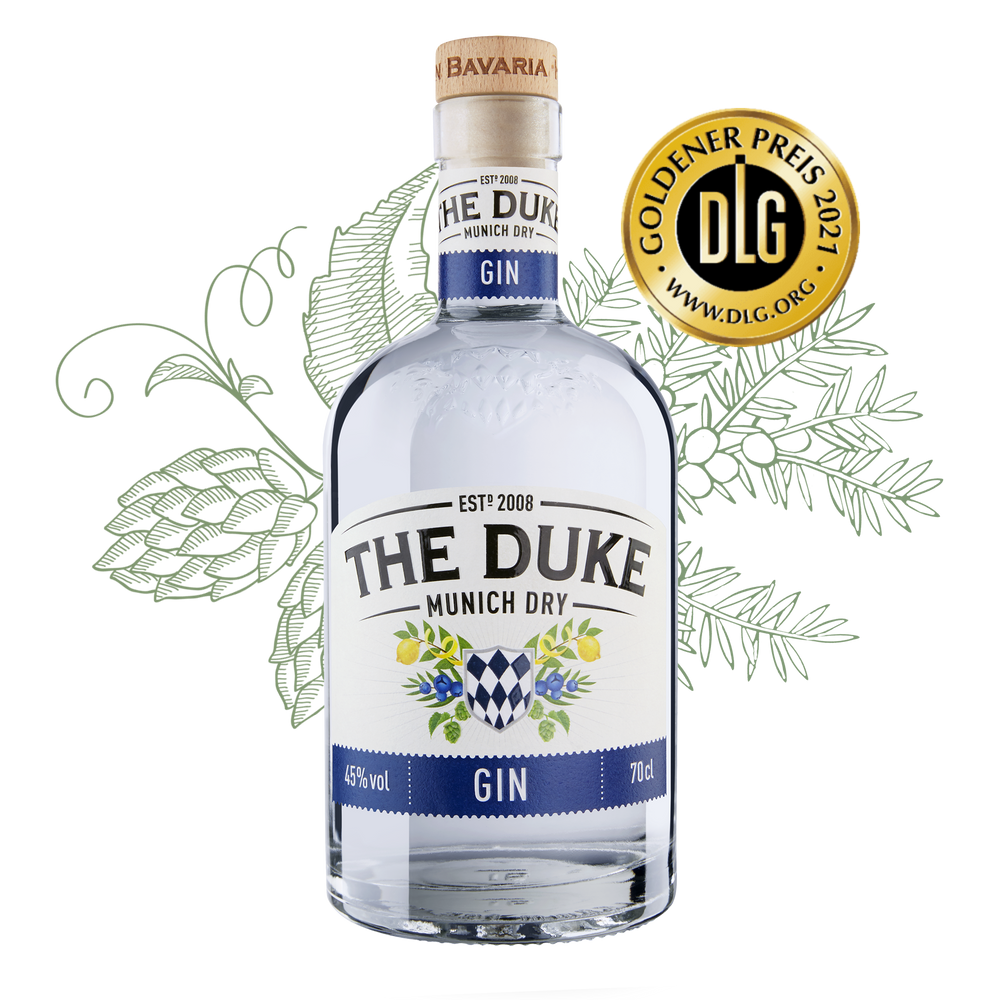Ohne Wacholder kein Gin

Bei der Gin-Herstellung spielen die verwendeten Kräuter und Gewürze – die sog. „Drogen“ oder auch „Botanicals“ (engl. für pflanzliche Extrakte) – eine essentiell wichtige Rolle, denn sie sind es, die dem Gin seinen einzigartigen Charakter verleihen. Bereits kleinste Anpassungen an der Rezeptur können den Geschmack des Destillats sehr stark beeinflussen. Typisch für einen Gin klassischer Bauart ist die im Vordergrund stehende Wacholderbeere.
Doch auch Rinden, Wurzeln, Samen, Körner, Kräuter und Früchte werden bei der Mazeration (Extraktionsverfahren) eingesetzt. Dabei sind den Kombinationsmöglichkeiten theoretisch keine Grenzen gesetzt. Die Liste der Kräuter ist unendlich lang: Salbei, Orangenblüten, Nelke, Brennnessel und zahlreiche weitere Kräuter zählen dazu. In der Botanical-Gruppe der Früchte sind neben Zitrusfrüchten und Beeren auch exotische Früchte wie Physalis, Kumquats oder Mango denkbar. Auch die Gruppe der Samen und Körnerzeichnet sich durch Vielfalt aus. Anis, Fenchel, Muskat, Vanille oder Malz sind nur einige Samen und Körner, die bei der Gin-Herstellung mazeriert werden können. In die Gruppe der Wurzeln und Rinden fallen schließlich beispielsweise Kurkuma, Ingwer, Angelikawurzel, Sandelholz oder Zimt.
Ohne weitere Botanicals kein THE DUKE Gin
Die Herstellung verläuft ganz klassisch mit vorangehender Mazeration und anschließender zweifacher Destillation mittels des Raubrand-Feinbrand-Verfahrens. Die Botanicals werden zunächst in einer Alkohol-Wasser-Mischung angesetzt und über Nacht mazeriert. Dabei werden die Gewürze von den feinwürzigen Aromen des Weizen-Ethanols getragen, die sich dabei selbst nicht in den Vordergrund drängen. Bei der Destillation ist es besonders wichtig, die komplexen Aromen der Drogen zu bewahren. Dies wird gewährleistet, indem sie langsam und aromaschonend von der kupfernen Brennblase in den Kühler geleitet werden. Anschließend sorgen zwei Filtrationen für die Reinheit und Weichheit des Destillats. Zuletzt wird eine zweite Destillation durchgeführt, welche das Destillat feiner und runder macht.

Die Botanicals
Wacholderbeere – Die Seele des Gins

Die Wacholderbeere ist nicht nur das wichtigste Botanical des Gins, sondern auch per Definition die Zutat, die in einem Destillat enthalten sein muss, um als Gin zu gelten. Wacholder gehört zu den immergrünen Zypressengewächsen und zählt 50 bis 70 Arten. In Mitteleuropa sind nur der Gemeine Wacholder und der Sadebaum vertreten. Das Holz besitzt einen schmalen Splint, einen rötlich-braunen Kern und duftet oft aromatisch. Die Blätter sind generell kurz und liegen eng an den Zweigen. Die ei- bis kugelförmigen Zapfen, im Volksmund „Beeren“ genannt, benötigen bis zur Reife ein bis zwei Jahre, bleiben geschlossen und werden bläulich. Die Wacholderbeere zeichnet sich durch einen süßlich-würzigen, leicht harzig-bitteren Geschmack aus und riecht sehr kräftig.
Koriandersamen– Der Sidekick
Koriander wird als Heilpflanze und Gewürzpflanze eingestuft und gehört zu den Doldengewächsen. Sie ist auch unter den Namen Cilantro, Asiatische/ Arabische Petersilie oder Schwindelkraut bekannt. Koriander ist vielen als Teil der Kräuterwelt geläufig. Die frischen Zweige entfalten einen Duft, der an Zitronengras und Moschus erinnert und werden gerne zum Würzen, Verfeinern oder Garnieren von warmen und kalten Speisen verwendet. Doch auch die kleinen, harten und kugelförmigen Samen werden oft als Gewürz eingesetzt. Sie enthalten bis zu zwei Drittel der wertvollen ätherischen Öle, die in der Pflanze enthalten sind und vielseitig genutzt werden können. Das außergewöhnliche und intensive Aroma wird auch bei der Herstellung von Gin geschätzt.
Zitronenschale – Die Zitrusnote
Die immergrünen Zitronenbäume bringen länglich-ovale Früchte mit gelber oder grün-gelber Schale hervor. Das saftige, saure Fruchtfleisch enthält rund 3,5 bis 8 % Zitronensäure und viel Vitamin C. Gerne werden Zitronenscheiben als Garnitur für Cocktails verwendet. In der Schale sitzen zahlreiche Öldrüsen, wodurch sie einen aromatischen Duft verströmt. So verleihen die ätherischen Öle auch dem THE DUKE Gin eine frische Fruchtnote. Die Zitronen werden von unseren Destillateuren von Hand geschält, bevor die Schale mazeriert wird.

Lavendelblüten – Die Florale Note

Die Pflanzengattung Lavendula umfasst auch die Pflanzenart Lavandula angustifolia, die im Deutschen den Namen Echter Lavendel trägt. Eben jene Pflanze ist fast immer gemeint, wenn es um Lavendel geht. Der typische Farbton der Blüten ist auch namensgebend für die Bezeichnung der entsprechenden Farbnuance, die dem Violett nahesteht. Da er trotz seiner Liebe zu Wärme winterhart ist, gedeiht er in Deutschland und seinen Nachbarländern gut. Der Lavendel ist ein graufilzig behaarter und aromatischer Strauch. Die Blütenstände bilden sich ährenartig aus und erinnern ein wenig an Getreide. Der Kelch der Blüte ist grauviolett, kurz flaumig und eiförmig-röhrig. Die violette Blütenkrone ist schwach zweilippig. Die Blütezeit reicht von Juni bis August. Lavendel ist eine häufig in der Heilkunde und Parfümerie geschätzte Pflanzengattung. Der florale, süßliche bis herbe Lavendelduft mag zwar an sich intensiv und unverwechselbar sein, doch dem Wacholderdestillat verleiht er lediglich eine angenehm leichte florale Note.
Ingwerwurzel – Scharfe Würze
Die Ingwerpflanze ist ein optisch an Schilf erinnerndes Kraut mit einer durchschnittlichen Wuchshöhe von 0,5 bis 1,5 Metern und langen Laubblättern sowie dicken Stängeln. Die Wurzel wächst knollenförmig mit mehreren Verästelungen, sowohl länglich als auch dicklich. Das Innere der Ingwerknolle weist einen hellen, gelblichen Farbton auf und ist faserig sowie saftig. Die Knolle wird von einer dünnen, bräunlichen Schale umgeben. Das typisch kräftige Aroma der Ingwerknolle und ihr scharfer, würziger Geschmack machen sich im Gin unterschwellig bemerkbar.
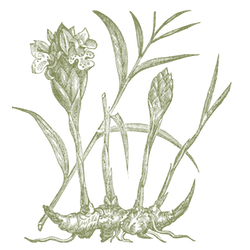
Kubebenpfeffer – Wärmende Würze

Bei diesem Pfeffergewächs handelt es sich um eine Kletterpflanze, deren zugespitzten, länglichen Blätter glatt sind. Ähnlich wie bei Getreide, wachsen die Blüten an Ähren und sind zierlich von weißer Farbe. Aus ihnen bilden sich die rauen und bräunlichen Früchte, die mit den Pfefferkörnern assoziiert werden. Diese haben einen eher süßlichen als scharfen Geschmack. Jede winzige Beere verfügt über einen kurzen, kleinen Stängel, der wie ein Schwänzchen wirkt und den alternativen Namen „Schwanz-Pfeffer“ inspiriert hat. Kubebenpfeffer erscheint wärmend würzig und pikant, aber nicht zu scharf oder herb. Zudem gilt er als aromatisch und langanhaltend.
Angelikawurzel – Der Engel unter den Botanicals
Die Angelikawurzel, auch Engelwurz, gehört zu den Doldengewächsen und kann bis zu zwei Meter hoch werden. Sie besitzt eine rübenartige, rotbraune Wurzel mit gelbem Milchsaft und treibt einen hohlen gerillten Stängel aus. Die großen Blätter sind hellgrün, die grünlichen Blüten ordnen sich in 20- bis 40-strahligen Doppeldolden an. Angelikawurzel enthält vor allem ätherisches Öl – es besteht zu 80 bis 90 Prozent aus Terpenen. Sie versprüht einen aromatischen, stark würzigen Geruch und einen zunächst aromatischen, dann schärfer und bitterer werdenden Geschmack.
Orangenblüten – Betörender Duft
Bei Orangen handelt es sich um die Früchte des Orangenbaumes, der immergrün ist und eine Kreuzung aus der Pampelmuse und der Mandarine darstellt. Dieser erreicht eine Wuchshöhe von bis zu 10 Metern. Seine jungen Zweige sind mit Dornen versehen. Orangenbäume besitzen duftende, weiße Blüten, wobei die Blütezeit im europäischen Raum von Februar bis Juni dauert. Aus den Orangenblüten bilden sich die runden, bis zu faustgroßen Früchte mit der charakteristisch gefärbten Schale. Der Duft der Orangenblüte ist eine herrliche Kombination aus frischen Zitrusaromen und einem mild-schweren honigähnlichen Duft.
Zimtrinde – Wärmende Wirkung
Der Zimtbaum ist ein immergrüner Baum mit dichtem Laub und kann eine Wuchshöhe von bis zu 10 Metern erreichen. Die großen Blätter sind ungeteilt, eiförmig-zugespitzt und haben bogenförmig verlaufende Hauptnerven. Zerreibt man die Blätter, verströmen sie einen Duft, der an Gewürznelken erinnert. Der Baum trägt außerdem in lockeren Rispen angeordnete, unscheinbare Blüten, die etwa 1,5 cm groß werden und eiförmige, dunkelviolette Früchte. Die Rinde wird entweder von den zwei bis drei Zentimeter langen Zweigen etwa 6 Jahre alter Bäume oder aber von den etwa zwei Jahre alten Wurzelschösslingen älterer Bäume gewonnen. Zimt verbreitet einen sehr charakteristischen, angenehm aromatischen Geruch. Der Geschmack ist leicht süß und herb-würzig zugleich.
Kümmel – Wohltuende Eigenschaften
Die sommergrüne, zweijährige krautige Pflanze mit rübenartiger Wurzel wächst 30 bis 80 Zentimeter hoch, bei günstigen Bedingungen auch bis zu 120 Zentimeter. Die Samenreife beginnt im Juni bis August. Die kleine kahle Spaltfrucht des Kümmels ist oval und zerfällt in zwei Einzelfrüchte. Diese leicht sichelförmig gebogenen und an beiden Enden spitzen Einzelfrüchte sind an der Außenseite dunkelbraun und an der Innenseite hellbraun gefärbt. Ihnen werden wohltuende Eigenschaften, wie antiseptisch, schmerzlindernd, antibakteriell, verdauungsfördernd, krampflösend und beruhigend nachgesagt. Beim Zerreiben der volkstümlich „Kümmelsamen“ genannten Einzelfrüchte wird ein charismatischer Duft frei. Kümmel besitzt einen süßlich-fruchtigen Geruch und würzig-scharfen Geschmack
Hopfen & Malz – Der Bayerische Einschlag

Hopfen ist eine Pflanzengattung der Familie der Hanfgewächse. Alle Hopfen-Arten kommen auf der Nordhalbkugel vor, wobei der wohl bekannteste Vertreter der Gattung der Echte Hopfen ist, da er zum Bierbrauen verwendet wird. Die einjährig bis ausdauernden krautigen Kletterpflanzen besitzen zackige Blätter und grün-gelbe Zapfen (auch Blüten genannt). Hopfen hat einen bitteren, leicht harzigen Geschmack, wobei sich im Destillat selbst eine fruchtig-florale Note herausbildet.
Malz beschreibt durch Mälzung gekeimtes und getrocknetes Getreide. Für die Herstellung werden meist spezielle Getreidesorten, zum Beispiel sog. Braugerste oder Brauweizen eingesetzt. Dabei wird das gereinigte Getreide in Wasser eingeweicht und zur Keimung gebracht, wodurch der Wassergehalt auf ca. 40% ansteigt. Nachdem die Keimlinge fünf bis sieben Tage gewachsen sind, wird die Keimung durch schonendes Trocknen beendet und die herausgewachsenen Keimlinge werden entfernt. Das Malz ist danach lagerfähig. Für die Weiterverarbeitung wird es geschrotet oder gemahlen.
THE DUKE Wanderlust Gin
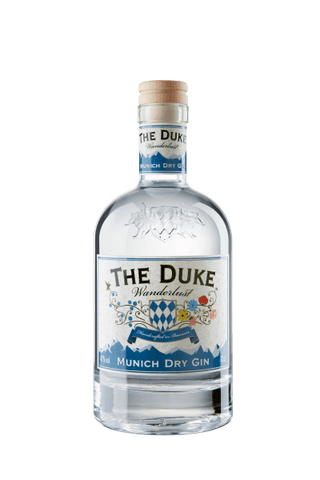
Der THE DUKE Wanderlust Gin spiegelt unsere Wanderlust und Heimatliebe gleichermaßen wider. Neben den klassischen Botanicals Wacholder und Koriander erhält das Destillat durch die feinen Blüten Edelweiß, Kornblume, Klatschmohn, Arnikablüte und Rosenblüte einen Hauch von Honigaroma und durch die Himbeere eine deutlich spürbare Fruchtnote. Die Kakaobohne sorgt für einen vollmundigen Körper des Destillats, Hopfen und Malz verleihen dem Gin den genuin bayerischen Einschlag.
THE DUKE Rough Gin – Die “Totale Reduktion”
Beim tagtäglichen Umgang mit einer Vielzahl an Kräutern und Gewürzen wächst die Wertschätzung eines jeden einzelnen Botanicals kontinuierlich. So ist es nicht verwunderlich, dass eines Tages beim Schreddern der Wacholderbeeren die Idee geboren wurde, einen Gin zu kreieren, der vor allem seine bestimmende Note Wacholder ehrt.
Der THE DUKE Rough Gin enthält nur fünf naturbelassene Zutaten, wodurch der kräftige Wacholder die Möglichkeit bekommt, geschmacklich mit voller Wucht hervorzutreten. Die Wacholderbeeren werden uns im halbtrockenen Zustand geliefert. Würde man sie vollständig trocknen, würden wichtige Aromen verloren gehen. Durch die schonende Halbtrocknung bildet sich stattdessen eine wohltuende Süße heraus. Als Nebendarsteller tritt ein wenig Koriander in Erscheinung und die Orangenschale, die sich bereits hervorragend als Garnitur für den DUKE & Tonic bewährt hat, liefert eine herrliche Frische. Unsere beiden bayerischen Klassiker Hopfenblüte und Malz runden den Rough Gin in gewohnt milder Art ab. Der Hopfen stammt aus der Kulturlandschaft Hallertau in der Mitte Bayerns, welche das größte zusammenhängende Hopfenanbaugebiet der Welt ist. Das Malz beziehen wir aus Bamberg in Oberfranken.

